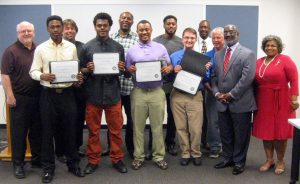
Has enviable record for getting graduates into construction jobs
By CARL GREEN
Correspondent
St. Louis – BUD (Building Union Diversity), a unique training program for minority, female and under-employed workers in partnership between St. Louis unions and contractors, has graduated its fifth class and is preparing for its next one.
But first things first. BUD’s leaders say they won’t start a new group until 70 percent of its latest graduates have become employed.
So far, that hasn’t been a problem. To date, 80-to-85 percent of the participants who graduated from earlier classes are now enrolled in union apprenticeship programs and have jobs with local contractors.
“This is not a home run – those numbers are a grand slam,” said John Gaal, director of training and workforce development for the St. Louis-Kansas City Carpenters Regional Council. “These are incredible numbers.”
Gaal spoke at the graduation ceremony for the newest group, with seven members, held at the Metropolitan St. Louis Sewer District (MSD) headquarters on Market Street in St. Louis.
The program was launched in 2014 to bring more minority workers into the union trades in a unique partnership the St. Louis Building & Construction Trades Council, the Eastern Missouri Laborers District Council and St. Louis-Kansas City Regional Carpenters Council, with funding help from the St. Louis Agency on Training and Employment (SLATE) and the Missouri Division of Workforce Development.
Today, nine participating unions are key to making the program work: Bricklayers Local 1, IBEW Local 1, Iron Workers Local 396, Laborers District Council of Eastern Missouri, Operating Engineers Local 513, Plumbers & Pipefitters Local 562, Insulators Local 1, Sheet Metal Workers Local 36 and the St. Louis-Kansas City Regional Carpenters Council.
 The newest group’s program was paid for by MSD, and the graduation audience included many contractors who work on MSD jobs and are interested in hiring program graduates.
The newest group’s program was paid for by MSD, and the graduation audience included many contractors who work on MSD jobs and are interested in hiring program graduates.
The participants were led by instructors Jim Duane, manager of the St. Louis Community College Workforce Solutons Group, and Pat Dolan, apprenticeship coordinator for the Missouri AFL-CIO and president of Sprinkler Fitters Local 268. But most of their hands-on experience came in training centers operated by participating unions, working full-time hours over about five weeks.
Of the seven participants in the most recent class, two already have jobs, two others had offers and a fifth was preparing for an interview this week.
JOBS ARE THE KEY
Gaal said the emphasis remains on getting the graduates into jobs.
“We’ve tried to adhere to something that President Obama put into his State of the Union speech two years ago,” Gaal said. “He said he wanted to put an end to spending taxpayer money on these ‘train and pray’ training programs.”
Such programs provide training but only a “prayer” when it comes to actually getting a job, he said.
“There were a lot of vendors out there that would get paid based only on the number of students they enrolled and graduated,” Gaal said. “President Obama said that doesn’t make sense.
“These are training programs, and therefore they should be training for jobs in the industry. And those jobs in the industry are the ones we need to connect these graduates to. That’s the success.”
Michael Holmes, executive director of SLATE, said the relationships between the program’s trainers and participants makes it stand out among training programs.
“Because we’re not just training,” he said. “We want to make sure the people we put in the program have a one-on-one experience, then we want to make sure they get placed before we even start another training program.
“Because then, at the end of the tunnel, there’s some light.”
GET TO WORK
Vicki Edwards, director of human resources for MSD, encouraged the graduates to meet the contractors who came to the event – even before anybody left the room.
 “You have to set yourself apart,” she said. “You have to be the one that’s up there a little early in the morning and stay a little later in the evening and give it everything you have in between. Those are the people these contractors in the room are looking for. Make sure they know who you are before they leave.”
“You have to set yourself apart,” she said. “You have to be the one that’s up there a little early in the morning and stay a little later in the evening and give it everything you have in between. Those are the people these contractors in the room are looking for. Make sure they know who you are before they leave.”
The program twice has been honored at the White House, providing recognition but also pressure to expand beyond the small-scale, personal approach that has worked so far.
“People in D.C. see we’re doing the right thing,” Gaal said. “They see those numbers and they know they’re significant, and they’re always trying to find how to scale the program up. But it’s not like going to Shop ‘n Save or Dierbergs down the street and buying a box of cookies. It doesn’t work like that.
“This stuff doesn’t just happen because somebody picked up the phone and said, ‘Let’s do this, it looks good.’ A lot of this happens because we have good people with good hearts in the room.”
APPLES AND APPLES
Holmes said the recognition keeps coming anyway because of the program’s success.
“We’re in for the good and the bad of it, but we’re trying to make a difference,” he said. “It’s not the end-all, but when we look at apples and apples, we’ll put this program up against any program in the country that is doing this type of training.”
In a survey of trade interest among the seven graduates, in which they could choose as many as they wished, six chose carpenter, six chose laborer, three said electrician, three said operating engineer and one said cement mason.
TO PARTICIPATE
People interested in signing up for future BUD classes may contact SLATE at (314) 657-3545.


I’m interested in getting more information on the BUD grant for our students at South and North Technical High Schools. When and how do students apply? What is the vetting process for new candidates? Are there any minimum age requirements?
Who can we contact for more info? Thanks!
People interested in signing up for future BUD classes may contact SLATE at (314) 657-3545.